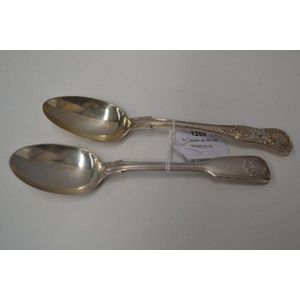Victorian Sterling Silver Dinner Spoon and EP Queens Pattern Spoon
You must be a subscriber, and be logged in to view price and dealer details.
Subscribe Now to view actual auction price for this item
When you subscribe, you have the option of setting the currency in which to display prices to $Au, $US, $NZ or Stg.
- Marrow Spoon - A spoon with a long handle and a narrow scoop shaped bowl, used to scoop and eat marrow from the hollow centre of roasted bones. Some marrow scoops are double ended with a different shaped bowl at each end.
- Sterling Silver - Sterling silver is a mixture of 92.5% pure silver and 7.5% of another metal, usually copper. Fine silver is 99.9% pure silver, and is relatively soft and the addition of the very small amount of copper gives the metal enough strength and hardness to be worked into jewellery, decorative and household objects.
- Victorian Period - The Victorian period of furniture and decorative arts design covers the reign of Queen Victoria from 1837 to 1901. There was not one dominant style of furniture in the Victorian period. Designers used and modified many historical styles such as Gothic, Tudor, Elizabethan, English Rococo, Neoclassical and others, although use of some styles, such as English Rococo and Gothic tended to dominate the furniture manufacture of the period.
The Victorian period was preceded by the Regency and William IV periods, and followed by the Edwardian period, named for Edward VII (1841 ? 1910) who was King of the United Kingdom and the British Dominions and Emperor of India for the brief period from 1901 until his death in 1910. - Ep / Epns - The abbreviation for electroplated and electroplated nickel silver, that is, silver plate.
The body of the piece is made of a common metal such as copper, and electroplating involves placing an extremely thin layer of silver on the surface of the piece. The resulting silver content is very small.
Unlike solid silver items, there is minimal underlying scrap value, and the value of such pieces is based on the quality, design and construction of the piece.
This item has been included into following indexes:
Visually similar items

A pair of sterling silver serving spoons, 1822/23, London with maker's mark William Esterbrook. Fiddle back spoons with fine reeded edges to the front and reverse and an embellishment in low relief to the throat; hallmarked. Silver weight 151gr length 23 c

Pair of 19th century French sterling silver spoons, marked Minerva, Henin & Fils 1872-5 Paris, approx 99g, 18 cm long

Two Old English pattern sterling silver basting spoons, John & Henry Lias, London 1819; WC, Dublin 1826, each with a drop heel, 228 grs total weight of silver

2 small sterling silver ladles Sheffield 1824, maker Samuel Harwood. Provenance: Allport Family
